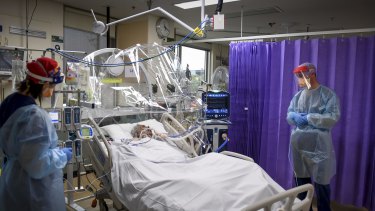Victoria has breached 800 COVID-19 hospitalisations, a milestone that could force health workers back from leave to cope with a serious winter wave and staff shortages.
National cabinet met on Saturday morning to respond to surging cases, with 9982 new infections recorded in Victoria and eight deaths. There were 802 people in hospital in the state on Saturday morning, the highest since February 1 when Omicron first exploded, and 34 people in intensive care.
There were 802 people in hospital in Victoria on Saturday morning.Credit:Penny Stephens
In NSW, a further 11,082 people tested positive with the virus, while 2024 people were hospitalised and 66 people admitted to intensive care. Across NSW, 38 COVID-positive people lost their lives.
The number of Victorians in hospital puts the state into stage three of the “health system winter response” plan, shared with hospital bosses, unions and key healthcare groups, as revealed by The Age this week.
Stage three includes regular emergency meetings, cancelling leave and ramping up telehealth consultations.
Dr Roderick McRae, the Victorian president of the Australian Medical Association, who was briefed on the winter response, said he believed it was a guideline and would not automatically trigger any changes.
Contingency plans for the worst-case scenarios could include a code brown declaration, a measure used to relieve short-term emergency pressures on hospitals. The phase four response could prioritise emergency surgeries. Additional crews could also be deployed to offload patients from ambulances to avoid “ramping” outside hospitals and to free up paramedics to respond to more patients.
“In very brutal terms, many of the health services have actually been managing at about stage four anyway,” McRae said.
Dr Roderick McRae, president of the Victorian branch of the Australian Medical Association.Credit:Joe Armao
The Victorian government said it has no intention of reintroducing a code brown, after the declaration was made for almost a month in January.
The Burnet Institute has projected the BA.4 and BA.5 subvariants of Omicron could overtake the summer surge of hospitalisations — when 1200 beds were filled with COVID-19 patients — in secret modelling for the state government.
Major hospitals have already started delaying some elective surgeries and hospitals are quickly expanding emergency departments.
Prime Minister Anthony Albanese said he had been advised the BA.4 and BA.5 wave is expected to peak in August.
Ahead of the emergency national cabinet meeting on Saturday, NSW Premier Dominic Perrottet suggested states and territories could revise mandatory isolation periods for COVID-positive people from seven days to five, or even less, once the current surge has passed.
“Ultimately, we have to get to a point where if you are sick you stay at home and if you are not sick, you can go to work,” he told news.com.au.
Addressing the media after that meeting, Albanese dead batted the issue. He said Chief Medical Officer Professor Paul Kelly had advised now was not the time to change isolation advice.
“But that is something that will continue to be monitored and will come from the health experts,” Albanese said.
Victorian Tourism Minister Steve Dimopoulos said the state’s current restrictions were minimal, but were “prudent and sensible” to help keep Victoria open.
Going to work sick is “just not acceptable anymore”, he said. “We know the risk that that holds to the entire community, let alone your office in your immediate work community.”
Dimopoulos welcomed the federal government’s decision to reinstate the $750 isolation payment, to be split with the states for the coming months.
“For us, the principle of staying at home when you’re sick is fundamentally important … any measure that allows people [and] incentivises people to stay home when they’re sick, is a measure that is worth putting on the table and worth supporting.”
The Morning Edition newsletter is our guide to the day’s most important and interesting stories, analysis and insights. Sign up here.
Most Viewed in National
From our partners
Source: Read Full Article

